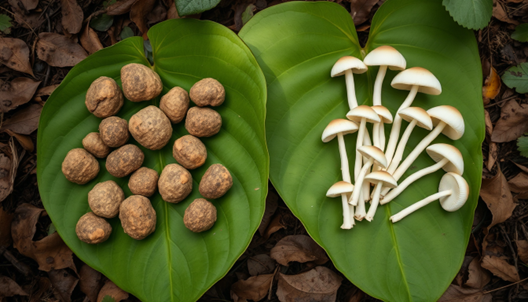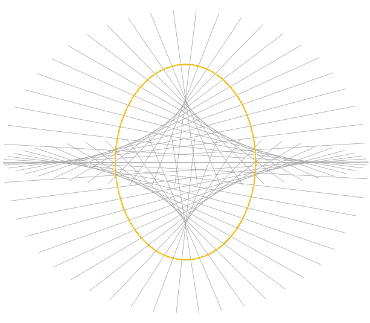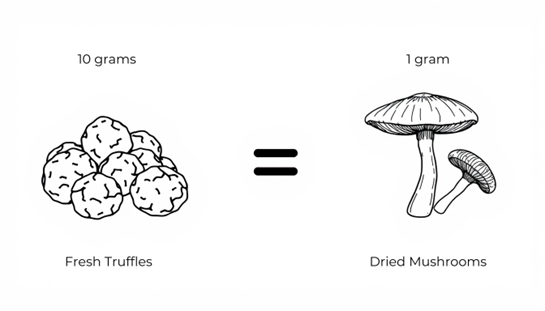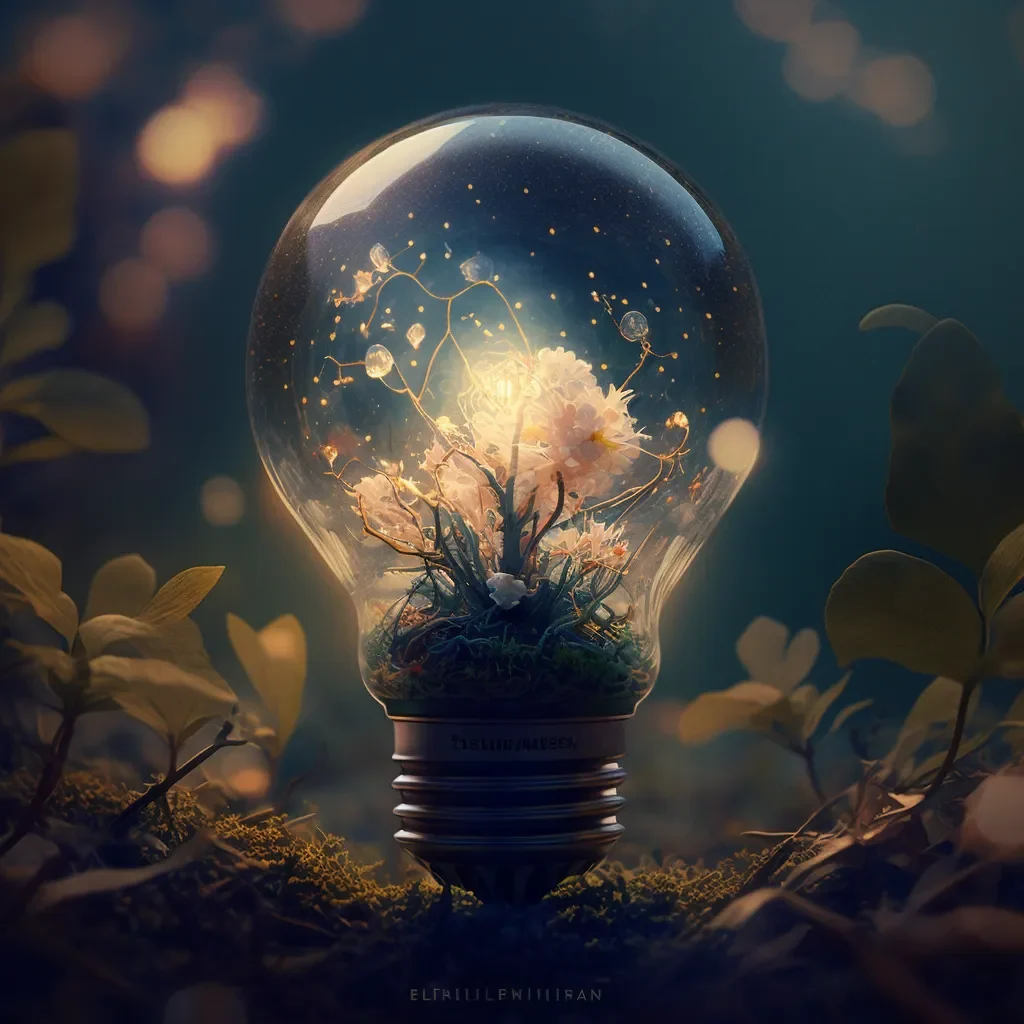Medvirkende forfatter
Fancisca Niklitschek
I denne artikel inviterer vi dig til at udforske, hvad psilocybin er, den psykoaktive forbindelse, der findes i magiske trøfler og magiske svampe. Denne guide vil hjælpe dig med at opdage denne fascinerende verden, som kan ændre din opfattelse og dit velbefindende.
Magiske trøfler vs. magiske svampe: Lad os undersøge, hvordan de forholder sig til hinanden
Psilocybintrøfler, ofte kaldet magiske trøfler, er en interessant form for psykoaktive svampe, der er tæt forbundet med magiske svampe. I stedet for svampe, som er de strukturer, der dukker op over jorden, er trøfler den underjordiske opbevaring af svampen, der videnskabeligt er kendt som sklerotier. Sclerotia tjener til at lagre næringsstoffer, så svampen kan forblive under hårde forhold.
Ligesom ved dyrkning af psilocybinsvampe er psilocybin sklerotier kan dyrkes i laboratoriet, hvilket indebærer dyrkning af psilocybinsvampesporer i kontrollerede miljøer og bevidst forhindring af, at forholdene bliver ideelle til fuld svampeudvikling. Som et resultat forbliver svampene i sklerotier sklerotier - som er kendt som trøffel - og høstes, når de når deres fulde størrelse, normalt inden for ca. 3 måneder, afhængigt af miljøforholdene og den specifikke stamme [1]. På dette tidspunkt indsamles sklerotierne manuelt og renses for eventuelle rester.

Billedet er skabt med Dall-E:
Til venstre ser du psilocybintrøfler og til højre psilocybinsvampe.
Både magiske trøfler og magiske svampe indeholder den samme psykedeliske forbindelse kaldet psilocybin, som er ansvarlig for deres transformerende effekter på bevidstheden gennem en psykedelisk oplevelse. Når psilocybin indtages, omdannes det til psilocin, som er ansvarlig for dybe forandringer i sindet. Det er dog kun nogle få svampearter, der producerer dette unikke stof.
Blandt de stammer, der indeholder psilocybin, kan vi finde Psilocybe Mexicanaen indfødt art fra Mexico - også kendt som "Pajaritos" eller "Little Birds" - som har en lang historie med brug i indfødte spirituelle praksisser. En anden bemærkelsesværdig stamme er Psilocybe Cubensis, også kendt som "Golden Teacher", som er en af de mest almindelige stammer af psilocybinsvampe og relativt begyndervenlig på grund af dens psilocybinindhold. Og så er der den, Psilocybe Tampanensissom ofte omtales som "De Vises Sten", er kendt for at producere sklerotier, som, som vi lærte tidligere, er de magiske trøfler, der er ansvarlige for at fremkalde ændrede bevidsthedstilstande.
Selvom den psykedeliske rejse med trøfler minder meget om den med svampe, er der nogle forskelle i, hvordan de indtages.
Hvad er de vigtigste forskelle mellem magiske trøfler og magiske svampe?
Den tydeligste forskel mellem trøfler og svampe ligger i deres udseende. Svampe, som vokser over jorden, kan have mange forskellige former og størrelser, hvilket fører til variationer i koncentrationen af psilocybin pr. gram. Det betyder, at styrken af en svamp kan variere betydeligt fra den ene til den anden.
På den anden side har trøfler - som udvikler sig under jorden - en lille og kompakt form, hvilket resulterer i en mere præcis konsistens i mængden af psilocybin i hver enkelt trøffel. Denne ensartethed i styrke gør det muligt at tilbyde en mere forudsigelig oplevelse.
En anden vigtig forskel er, at trøfler indeholder mindre vand, hvilket giver dem en fastere og mere robust tekstur. I modsætning hertil er svampe fortsat blødere og mere fleksible, selv efter at de er blevet tørret. Det er på grund af disse forskelle i konsistens, at der er brug for en større mængde friske trøfler for at matche intensiteten af tørrede svampe. Typisk svarer 1 gram tørrede svampe nogenlunde til ca. 10 gram friske trøfler.
Billedet er skabt med Dall-E:
Sammenligning af mængder, der kræves for at opnå samme effekt.
Med hensyn til rejsens intensitet er der ingen nævneværdig forskel på at indtage trøfler eller magiske svampe, da begge indeholder psilocybin, den forbindelse, der genererer den psykedeliske oplevelse. Indtagelse af begge dele kan sætte dig på en transformativ rejse, der giver plads til en følelse af samhørighed og tilfredsstillelse og fører til en dybt introspektiv tilstand. Gennem denne oplevelse er du i stand til at udforske dit sinds dybder, afdække skjulte følelser og forbinde dig med verden omkring dig på måder, der er dybt berigende.
En opfattet forskel blandt folk, som dog ikke er videnskabeligt underbygget, er, at trøfler nogle gange betragtes som mindre intense end svampe. Denne opfattelse kan skyldes, hvordan trøfler typisk sælges og indtages: De vejes ofte mere præcist, er tydeligt mærket med deres styrke og kommer med detaljerede brugsanvisninger. Dette tilskynder dem, der vælger trøfler, til at indtage dem mere omhyggeligt, hvilket fører til det indtryk, at deres virkninger er mildere. Desuden er det lettere at tygge 2 gram tørrede svampe end at gøre det med det, der svarer til 20 gram friske trøfler. Derfor kan det godt være, at folk ender med at indtage flere tørrede svampe pr. tur, end de ville med magiske trøfler.
Men, og det er den vigtige pointe, rejsens intensitet afhænger ikke af, om folk spiser svampe eller trøfler, men udelukkende af den mængde psilocybin, de indtager.
Det juridiske landskab for magiske trøfler a.k.a. psilocybintrøfler
Magiske trøfler er underlagt restriktioner i mange lande, men de har en særlig status i Holland, hvor de er fuldt lovlige, momsbelagte og kan købes i autoriserede smart-shops. Det gør landet til en unik destination for dem, der er interesserede i at udforske psykedeliske oplevelser. I modsætning til magiske svampe, som blev forbudt i 2007 i Holland, blev trøfler undtaget fra dette forbud, så de fortsat er tilgængelige på markedet.
En af de vigtigste fordele ved denne juridiske ramme er muligheden for at regulere doseringen af trøfler med større præcision. Fordi trøfler sælges lovligt over hele landet, er de omhyggeligt mærket, ofte med detaljerede oplysninger om deres styrke. Det gør det meget nemmere at måle og kontrollere indtaget, hvilket giver en mere sikker og forudsigelig oplevelse og reducerer risikoen for uventede eller overvældende virkninger.
Tilgængeligheden af lovlige trøfler har også fremmet en kultur med ansvarligt forbrug. De, der er interesserede i at udforske de psykedeliske effekter af magiske trøfler, kan drage fordel af professionel vejledning og deltage i psilocybin-assisterede retreats i Holland med trøffelceremonier, som dem, der tilbydes af Evolute Institute. Denne tilgang til forbrug forbedrer ikke kun den individuelle sikkerhed, men fremmer også en mere positiv og transformativ psykedelisk oplevelse. Hvis du vil vide mere om vores psilocybin-retreats, inviterer vi dig til at læse her.
Udforsk den mystiske verden af psilocybin
Som vi har lært før, er psilocybin et stærkt psykedelisk stof, som findes i visse typer svampe, der er almindeligt kendt som "magiske trøfler" og "magiske svampe". Dette ældgamle stof har fremkaldt utallige spirituelle rejser og transformative oplevelser gennem tiden og har været en vigtig bidragyder til menneskehedens søgen efter indre visdom og personlig vækst. Dens fornyede interesse i moderne videnskab fremhæver dens bemærkelsesværdige virkninger og potentiale for personlig og kollektiv transformation og helbredelse. Hvis du vil dykke dybere ned i de psykedeliske stoffers historie og deres kulturelle anvendelse gennem tiden, kan du læse vores artikel om De psykedeliske stoffers historie.
Når psilocybin indtages, omdannes det til psilocin i kroppen, som er den psykoaktive forbindelse, der er ansvarlig for de psykedeliske virkninger. Psilocin interagerer primært med serotoninreceptorer i hjernen, hvilket fører til ændringer i, hvordan hjernen behandler sensorisk og følelsesmæssig information. Forskning har vist, at psykedeliske stoffer, hvor psilocybin er et førende eksempel, kan fremkalde ændringer i hjernens forbindelser, hvilket fremmer en ændret bevidsthedstilstand og ofte en følelse af enhed med omgivelserne og sig selv. Hvis du vil vide mere om, hvordan psilocybin påvirker hjernen, kan du læse vores artikel Din hjerne på psykedeliske stoffer: Introduktion til neurovidenskaben bag psilocybin.
Undersøgelser har også vist, at psykedeliske oplevelser, herunder dem, der faciliteres af psilocybin, kan have positive effekter på psykiske problemer som depression, angst, afhængighed og posttraumatisk stresslidelse (PTSD) [1]-[3]. Disse nye beviser fremhæver psilocybins potentiale som terapeutisk værktøj og giver nyt håb for mennesker, der har kæmpet med disse tilstande og ikke har fundet lindring gennem traditionelle behandlingsformer.
Psilocybin kan give oplevelser, der er dybt transformerende. Det har evnen til at invitere til introspektion og skabe en dyb følelse af enhed med universet. Synæstesi forekommer ofte og blander sanserne på fængslende måder, farver kan høres og lyde ses. Tidsopfattelsen ændres også, den kan strække sig og skifte, mens der ofte opstår en omsluttende følelse af transcendens og spirituel forbindelse. Hvis du er interesseret i at forstå mere om disse oplevelser, kan du læse Et kig ind i den psykedeliske oplevelse.
Billedet er skabt med Dall-E:
Psilocybin som en døråbner til dyb selvrefleksion
Et psilocybin-trip varer typisk mellem fire og otte timer, afhængigt af dosis og den enkeltes følsomhed. Virkningen af rejsen kan forstærkes yderligere af et designet miljø, der støtter enkeltpersoner gennem hele oplevelsen og sikrer, at dens virkninger giver genlyd længe efter, at den psykedeliske rejse er afsluttet.
For dem, der søger et omhyggeligt udvalgt miljø, der passer til deres personlige behov for professionalisme og enestående kvalitet, tilbyder Evolute Institute psilocybin-retreats, der er omhyggeligt skabt til at give en lovlig, sikker og dybtgående oplevelse. For at finde ud af, hvilket retreat i Holland der passer bedst til dig, kan du læse vores artikel Sådan vælger du en psykedelisk Retreat, der stemmer overens med dine personlige værdier og overbevisninger.
Men hvad er fordelene ved psilocybin? Er det mere end bare en oplevelse?
For at forstå de positive effekter af psilocybin deler vi analysen op i to typer indtag: mikrodosering og makrodosering.
Mikrodosering betyder, at man tager en lille, subperceptuel mængde psilocybin over en længere periode (normalt 2-3 måneder med flere indtag om ugen) med det formål subtilt at forbedre dagligdags aspekter som kreativitet og generelt velbefindende. Selv om mange mennesker rapporterer om positive erfaringer med mikrodosering, er den videnskabelige støtte stadig begrænset og kræver yderligere forskning. Hvis du er interesseret i at få flere detaljer om al den eksisterende videnskab om mikrodosering, kan du læse vores dybdegående artikel, der er linket til her.
I modsætning hertil indebærer makrodosering indtagelse af en betydelig dosis psilocybin, hvilket fører til en mere intens og berigende oplevelse. Når de indtages i sikre omgivelser med professionel facilitering, beskriver folk ofte disse oplevelser som nogle af de mest dybtgående og transformerende i deres liv, der kan sammenlignes med store livsbegivenheder som f.eks. et barns fødsel eller tabet af en elsket person [4]. Denne dybe virkning understøttes af videnskabelig dokumentation, som viser, at makrodosering under de rette betingelser er både sikker og effektiv [5]-[8]. Det er bemærkelsesværdigt, at mange mennesker oplever, at en enkelt makrodosis, især med psilocybin, kan føre til varige forbedringer i følelsesmæssigt velvære, selvforståelse og åndelig vækst, så længe oplevelsen er velintegreret, efter at rejsen er slut [4].
Derudover har psilocybin vist potentiale til at fremkalde positive ændringer i forskellige psykologiske dimensioner, herunder humørforbedring, åndeligt velvære og øget neuroplasticitet: hjernens evne til at reorganisere og danne nye neurale forbindelser [9]-[14].
Mens psilocybins virkninger viser et lovende potentiale, er det vigtigt at anerkende de tilknyttede risici. Den psykedeliske oplevelse kan være dybt udfordrende for nogle mennesker og potentielt føre til episoder med angst eller paranoia. Det er vigtigt at bemærke, at disse udfordringer, der ofte omtales som "dårlige trips", kan give mulighed for at konfrontere og bearbejde dybtliggende følelser og traumer, og de giver mulighed for at forandre dit liv. Forudsætningerne for at udnytte vanskelige psykedeliske oplevelser til din personlige vækst er selvfølgelig et sikkert og professionelt miljø og grundig mental og følelsesmæssig forberedelse og integration. Hvis du vil vide mere om udfordringerne og kompleksiteten i en udfordrende oplevelse, kan du gå på opdagelse i Paradokset med den dårlige rejse.
Hvis tanken om et psilocybin-retreat vækker genklang i dig, og du er interesseret i at udforske dets virkninger i et sikkert og ekspertstyret miljø, har Evolute Institute specialiseret sig i at ledsage folk gennem lovlige, professionelt tilrettelagte og medicinsk overvågede psilocybin-trøffelrejser i Holland.
Hos Evolute Institute er en gruppeceremoni med psilocybintrøfler designet som en unik og dybt personlig rejse mod dyb indre vækst. Vores psilocybin-retreats med magiske trøfler understøttes af et tværfagligt team af eksperter (læger, psykologer, gestaltterapeuter, psykedeliske facilitatorer, integrationseksperter, ledelsescoaches og eksperter i åndedrætsarbejde), som alle er dedikerede til at skabe et rum, hvor du kan begive dig ud på en dybt transformerende rejse.
Billedet er skabt med Dall-E: Tag med på rejsen, og kom et skridt nærmere på at vække dit sande potentiale.
Forestil dig at træde ind i et rum, hvor hvert øjeblik er skabt til at være sikkert, støttende og transformerende. Fra starten vil du deltage i tankevækkende forberedelser og komme i kontakt med andre på en meningsfuld måde, så der er lagt op til en stærk og fordybende oplevelse. Under ceremonien vil du udforske nye dimensioner af din bevidsthed, og bagefter vil du få vejledning til at integrere disse indsigter i din hverdag. Med ekspertstøtte ved din side er dette retreat en særlig chance for at udforske dit sinds dybder, afdække nye muligheder for personlig vækst, dybere selvudforskning og komme tættere på dit sande formål.
Er du klar til at udforske denne transformerende oplevelse yderligere? Opdag, hvad et psilocybin-retreat hos Evolute Institute kan tilbyde dig ved at læse Hvad du kan forvente af en psilocybin-gruppe Retreat på Evolute Institute. For at få et inspirerende indblik i andres transformative rejser inviterer vi dig til at fordybe dig i en inspirerende førstepersonsfortælling. her.
Bibliografi
[1] J. Gartz, J. W. Allen og M. D. Merlin, "Ethnomycology, biochemistry, and cultivation of Psilocybe samuiensis Guzman, Bandala og Allen, en ny psykoaktiv svamp fra Koh Samui, Thailand," Tidsskrift for Etnofarmakologi, vol. 43, no. 2, pp. 73-80, 1994.
[2] Y. Yao, D. Guo, T. S. Lu, F. L. Liu, S. H. Huang, M. Q. Diao, ... & Y. Han, "Effektivitet og sikkerhed ved psykedelika til behandling af mentale lidelser: En systematisk gennemgang og metaanalyse". Psykiatrisk forskning, vol. 115886, 2024.
[3] H. C. Santos og J. G. Marques, "Hvad er den kliniske dokumentation for psilocybin til behandling af psykiatriske lidelser? En systematisk gennemgang". Porto Biomedical Journal, vol. 6, no. 1, p. e128, 2021.
[4] R. L. Carhart-Harris, M. Bolstridge, J. Rucker, C. M. Day, D. Erritzoe, M. Kaelen, ... & D. J. Nutt, "Psilocybin med psykologisk støtte til behandlingsresistent depression: et åbent gennemførlighedsstudie," The Lancet Psykiatri, vol. 3, no. 7, pp. 619-627, Jul. 2016.
[5] R. R. Griffiths, W. A. Richards, U. McCann og R. Jesse, "Psilocybin can occasion mystical-type experiences having substantial and sustained personal meaning and spiritual significance," Psychopharmacology (Berl.), vol. 187, no. 3, pp. 268-283, Aug. 2006, doi: 10.1007/s00213-006-0457-5.
[6] A. T. Hodge, S. Sukpraprut-Braaten, M. Narlesky og R. C. Strayhan, "The Use of Psilocybin in the Treatment of Psychiatric Disorders with Attention to Relative Safety Profile: A Systematic Review", J. Psychoactive Drugs, vol. 55, no. 1, pp. 40-50, Jan. 2023, doi: 10.1080/02791072.2022.2044096.
[7] S. Dodd et al, "Psilocybin in neuropsychiatry: a review of its pharmacology, safety, and efficacy," CNS Spectr. vol. 28, no. 4, pp. 416-426, Aug. 2023, doi: 10.1017/S1092852922000888.
[8] P. Sharma et al, "Psilocybins historie, handling og reaktion: A narrative clinical review," J. Psychopharmacol. (Oxf.), vol. 37, no. 9, pp. 849-865, Sep. 2023, doi: 10.1177/02698811231190858.
[9] D. Kaminski og J. P. Reinert, "The Tolerability and Safety of Psilocybin in Psychiatric and Substance-Dependence Conditions: A Systematic Review", Ann. Pharmacother, s. 10600280231205645, okt. 2023, doi: 10.1177/10600280231205645.
[10] D. B. Goel og S. Zilate, "Potentielle terapeutiske virkninger af psilocybin: A Systematic Review," Cureus, vol. 14, no. 10, p. e30214, doi: 10.7759/cureus.30214.
[11] J. van Amsterdam og W. van den Brink, "Det terapeutiske potentiale for psilocybin: en systematisk gennemgang," Expert Opin. Drug Saf., vol. 21, no. 6, pp. 833-840, Jun. 2022, doi: 10.1080/14740338.2022.2047929.
[12] S. Shnayder, R. Ameli, N. Sinaii, A. Berger og M. Agrawal, "Psilocybin-assisteret terapi forbedrer psyko-social-åndelig velvære hos kræftpatienter," J. Affect. Disord. vol. 323, pp. 592-597, Feb. 2023, doi: 10.1016/j.jad.2022.11.046.
[13] K. M. Baker, C. M. Ulrich og S. H. Meghani, "An Integrative Review of Measures of Spirituality in Experimental Studies of Psilocybin in Serious Illness Populations", Am. J. Hosp. Palliat. Med., vol. 40, no. 11, pp. 1261-1270, Nov. 2023, doi: 10.1177/10499091221147700.
[14] E. Whinkin, M. Opalka, C. Watters, A. Jaffe og S. Aggarwal, "Psilocybin in Palliative Care: An Update", Curr. Geriatr. Rep., vol. 12, no. 2, pp. 50-59, Jun. 2023, doi: 10.1007/s13670-023-00383-7.
[15] R. Nardou et al, "Psychedelics reopen the social reward learning critical period," Nature, vol. 618, no. 7966, Art. no. 7966, Jun. 2023, doi: 10.1038/s41586-023-06204-3.

Patrick Liebl,
Ledende facilitator og integrationsekspert
Er Retreat-programmet det rigtige for din personlige udviklingsrejse?
Vi inviterer dig til at planlægge et opkald med os. Sammen kan vi udforske eventuelle spørgsmål eller bekymringer, du måtte have. Vi kan undersøge, om dette program er det rigtige for dig på nuværende tidspunkt og sikre, at du føler dig tryg ved og klar til at tage imod denne transformerende oplevelse.
"Vi er her for at støtte din udforskning, i dit tempo, uden forventninger." - Patrick Liebl






